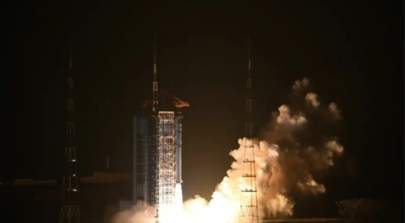China launches first solar observatory, tests grid fins
Source: https://spacenews.com/china-launches-first-solar-observatory-tests-grid-fins/
HELSINKI — China carried out its 37th orbital launch of the year Thursday, successfully sending the Chinese H-alpha Solar Explorer and 10 other satellites into orbit.
A Long March 2D lifted off from Taiyuan, north China, at 6:51 a.m. Eastern, Oct. 14. The rocket used a new configuration to allow it to deploy more than 10 satellites for the first time while the first stage also included grid fins—following earlier tests on other Long March rockets—to constrain the expected drop zone of the stage downrange.
The main payload was China’s first solar observatory, the Chinese H-alpha Solar Explorer, with a target 517-kilometer-altitude Sun-synchronous orbit.
An orbital atmospheric density detection experimental satellite (MD-1) and a commercial meteorological detection constellation experimental satellite (QX-1) were also aboard the flight, Xinhua reports. The pair were developed by small satellite developer Shenzhen Aerospace Dongfanghong Satellite Co., Ltd, ultimately owned by the China Aerospace Science and Technology Corporation (CASC).
The China Great Wall Industry Corporation (CGWIC), a subsidiary of CASC, lists further satellites on the flight to be named as MD-1, Tianshu-1, QX-1, the Golden Bauhinia N2 satellite developed by Hong Kong Aerospace Technology Group Limited and Commsat for a constellation to cover the Guangdong-Hong Kong-Macao Greater Bay Area, MOTS and Tianyuan-1, as well as Head-2 E and Head-2 F for the HEAD Aerospace Group.
Tianshu-1 is a test satellite for low Earth orbit navigation enhancement for Insight Position Digital Intelligence Technology Service Co., Ltd.
MOTS refers to a VHF Data Exchange System (VDES) experiment satellite developed by Shanghai Lizheng Satellite is expected to form the basis for a Chinese maritime communication constellation.
The last pair of satellites were for a Asia-Pacific Space Cooperation Organization (APSCO) student small satellite project, namely the SSS-1 Micro Satellite and SSS-2A Cube Satellite.
The 508-kilogram CHASE is tasked with acquiring the first full-disk spectroscopic solar observations in the H-alpha deep-red visible spectral line waveband. CHASE will study solar activity and provide critical data for space weather forecasting, including observing filaments prior to eruptions of solar flares and coronal mass ejections.
The mission has a design lifetime of three years and is planned to make observations up to the upcoming 2025 solar maximum. It also carries the name Xihe, for a solar deity from Chinese mythology, following a public contest to name the mission.
The satellite is based on a new platform with its very high pointing accuracy and high stability reaching 1 to 2 orders of magnitude higher than existing domestic capabilities, according to the platform developer, the Shanghai Academy of Space Technology (SAST), a major CASC subsidiary. The Changchun Institute of Optics, Fine Mechanics and Physics (CIOMP) of the Chinese Academy of Sciences (CAS) was involved in the development of CHASE. The new platform makes the mission in part a technology verification test. SAST also provided the Long March 2D for the mission.
China is planning to follow CHASE with the launch of the Advanced Space-born Solar Observatory (ASO-S) in 2022.
China’s next launch will be the Shenzhou-13 crewed mission to the Chinese space station core module, Tianhe, launching 12:23 Eastern Friday, October 15.
CASC is aiming to launch more than 40 times in 2021, with commercial launch providers adding to this total.












